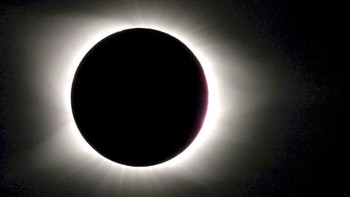
Because we see the sun and the stars and the moon almost every day, it is very easy to stop thinking about what they actually are. In this article we take a look at both the sun and moon individually and the nature of the cosmic ballet that results in a solar eclipse.
The Sun
Let’s start with the Sun, in cosmological terms our Sun is a middle-aged adult, roughly halfway through its life. Our Sun was ‘born’ around 4.6 billion years ago, formed out of a massive field of hydrogen gas. These interstellar clouds, as we call them, consist mostly of hydrogen, with small amounts of helium and lithium and can stretch for hundreds of light years. There will be areas of these clouds which are ever so slightly more dense than other areas. Where these denser areas occur, their gravitational pull is stronger and so they pull in more hydrogen and become denser.
Over billions of years these clumps continue to grow until eventually they are massive balls of hydrogen gas. Once they reach a critical point and the pressure in the center becomes great enough a process called nuclear fusion begins. Nuclear fusion occurs when the energy at the center of, what is now a star, is great enough that positively charged hydrogen ions are able to overcome their electromagnetic repulsion and fuse together to form helium. Our sun is a beautiful thing and has many positive connotations for us, from heat and warmth, to happiness. However, despite its beauty it is fueled by one of the most violent reactions in nature. 99% of the mass in our solar system resides within this gigantic ball of plasma.
The Moon
You may well be asking then ‘where does our moon come from?’ After all, our moon is made of rock, much like the earth, and whereas hydrogen was produced in sufficient quantities to seed our galaxies and universe as a result of the big bang, rock is a much more complex substance requiring multiple elements.
The clue as to the origin of our moon lies in its composition, it is almost exactly that of Earth. We now understand that this is because in our ancient past our planet collided with another planet. This collision had two important effects, firstly it ejected matter from the Earth. This matter coalesced in to the moon. At the same time the planet we collided with sunk through the Earth’s still molten surface, the metallic elements contained within sank straight through to our core and consequently we now have an electromagnetic shield which protects our planet from cosmic rays.
Solar Eclipse
Eclipses are relatively rare events, but we will all experience them during our lives. The weather channel Utah even livestreamed the last one. Few of us really ever consider what it is that we are seeing though, this is a shame because our solar system truly is a thing of beauty.
The Moon orbits the Earth, while the Earth orbits our Sun. Sometimes, by sheer coincidence, the moon is positioned between the Earth and the Sun and so we get an eclipse. Doesn’t sound impressive right?
Well consider this, it is purely by chance that our Sun is the size and distance from us that it is, and it is purely by chance that our planet once collided with another planet and this collision produced a moon, which just happens to be the perfect size and distance from our planet to fit almost perfectly over the Sun and block its light when an eclipse occurs.
The universe beyond our Earth is a truly remarkable thing, it is an endless expanse of death and nothingness and yet out of that comes the most staggering displays of beauty.
